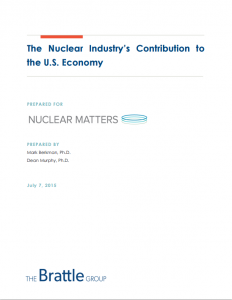Full Title: The Nuclear Industry’s Contribution to the U.S. Economy
Author(s): Mark Berkman, Ph.D and Dean Murphy, Ph.D
Publisher(s): The Brattle Group
Publication Date: July 1, 2015
Full Text: Download Resource
Description (excerpt):
Nuclear power currently accounts for 19% of U.S. power production, but several factors are at play that may threaten some nuclear generators and could diminish the nuclear industry’s contribution to our electricity supply and the U.S. economy. These factors include limited recognition of carbon as a social cost, as well as market factors such as low natural gas prices, flat electricity demand growth, and transmission constraints. At the request of Nuclear Matters, The Brattle Group has estimated the value of the entire nuclear industry to the U.S. economy, and its contribution to limiting greenhouse gas emissions, to inform the discussion of whether and how these factors should be addressed.
These values reflect the incremental contribution of the nuclear industry to the economy, measured by comparing the performance of the U.S. economy with and without the nuclear fleet. This approach nets off the contribution of the alternative generation that would be necessary if the nuclear industry did not exist, to determine its incremental contribution. Without nuclear plants, the economy would rely more heavily on existing and new natural gasfired generating plants, and to a lesser extent, additional generation from existing coal-fired plants. This greater use of fossil generation would mean higher electricity prices – wholesale prices would be 10% higher on average; retail prices would rise about 6%. It is this effect on electricity prices that accounts for the majority of nuclear’s overall incremental economic impact.
Increased fossil use would also result in much higher carbon dioxide emissions and greater emissions of criteria pollutants such as NOX and SO2. Large-scale renewable energy would probably not substitute significantly for nuclear; intermittent renewable generation is not a direct substitute for the baseload profile of nuclear.
The magnitude of the power price effects, and ultimately the economic and jobs effects, could depend on movements in the price of natural gas, since it plays a primary role in setting power prices in most U.S. regions.1 Lower natural gas prices are a primary reason for the current threat to some nuclear plants, of course, but the sensitivity of this analysis to gas prices also points out that nuclear plants help to protect consumers and the economy from the volatility of gas prices. These effects go well beyond what consumers pay for natural gas directly, and even beyond what they pay for electricity, since power prices have a significant effect on the larger economy, as is demonstrated by this study.
Absent nuclear, consumers would pay more for electricity, the economy would suffer both in terms of GDP and jobs, and we would face substantially higher emissions of CO2 and other pollutants.
